SNVSA21G May 2014 – October 2017 LP8860-Q1
PRODUCTION DATA.
- 1 Features
- 2 Applications
- 3 Description
- 4 Revision History
- 5 Device Comparison Table
- 6 Pin Configuration and Functions
-
7 Specifications
- 7.1 Absolute Maximum Ratings
- 7.2 ESD Ratings
- 7.3 Recommended Operating Conditions
- 7.4 Thermal Information
- 7.5 Electrical Characteristics
- 7.6 Current Sinks Electrical Characteristics
- 7.7 Boost Converter Characteristics
- 7.8 Logic Interface Characteristics
- 7.9 VIN Undervoltage Protection (VIN_UVLO)
- 7.10 VDD Undervoltage Protection (VDD_UVLO)
- 7.11 VIN Overvoltage Protection (VIN_OVP)
- 7.12 VIN Overcurrent Protection (VIN_OCP)
- 7.13 Power-Line FET Control Electrical Characteristics
- 7.14 External Temp Sensor Control Electrical Characteristics
- 7.15 I2C Serial Bus Timing Parameters (SDA, SCLK)
- 7.16 SPI Timing Requirements
- 7.17 Typical Characteristics
-
8 Detailed Description
- 8.1 Overview
- 8.2 Functional Block Diagram
- 8.3 Feature Description
- 8.4 Device Functional Modes
- 8.5 Programming
- 8.6
Register Maps
- 8.6.1
Register Bit Explanations
- 8.6.1.1 Display/Cluster1 Brightness Control MSB
- 8.6.1.2 Display/Cluster1 Brightness Control LSB
- 8.6.1.3 Display/Cluster1 Output Current MSB
- 8.6.1.4 Display/Cluster1 Output Current LSB
- 8.6.1.5 Cluster2 Brightness Control MSB
- 8.6.1.6 Cluster2 Brightness Control LSB
- 8.6.1.7 Cluster2 Output Current
- 8.6.1.8 Cluster3 Brightness Control MSB
- 8.6.1.9 Cluster3 Brightness Control LSB
- 8.6.1.10 Cluster3 Output Current
- 8.6.1.11 Cluster4 Brightness Control MSB
- 8.6.1.12 Cluster4 Brightness Control LSB
- 8.6.1.13 Cluster4 Output Current
- 8.6.1.14 Configuration
- 8.6.1.15 Status
- 8.6.1.16 Fault
- 8.6.1.17 LED Fault
- 8.6.1.18 Fault Clear
- 8.6.1.19 Identification
- 8.6.1.20 Temp MSB
- 8.6.1.21 Temp LSB
- 8.6.1.22 Display LED Current MSB
- 8.6.1.23 Display LED Current LSB
- 8.6.1.24 Display LED PWM MSB
- 8.6.1.25 Display LED PWM LSB
- 8.6.1.26 EEPROM Control
- 8.6.1.27 EEPROM Unlock Code
- 8.6.2
EEPROM Bit Explanations
- 8.6.2.1 EEPROM Register 0
- 8.6.2.2 EEPROM Register 1
- 8.6.2.3 EEPROM Register 2
- 8.6.2.4 EEPROM Register 3
- 8.6.2.5 EEPROM Register 4
- 8.6.2.6 EEPROM Register 5
- 8.6.2.7 EEPROM Register 6
- 8.6.2.8 EEPROM Register 7
- 8.6.2.9 EEPROM Register 8
- 8.6.2.10 EEPROM Register 9
- 8.6.2.11 EEPROM Register 10
- 8.6.2.12 EEPROM Register 11
- 8.6.2.13 EEPROM Register 12
- 8.6.2.14 EEPROM Register 13
- 8.6.2.15 EEPROM Register 14
- 8.6.2.16 EEPROM Register 15
- 8.6.2.17 EEPROM Register 16
- 8.6.2.18 EEPROM Register 17
- 8.6.2.19 EEPROM Register 18
- 8.6.2.20 EEPROM Register 19
- 8.6.2.21 EEPROM Register 20
- 8.6.2.22 EEPROM Register 21
- 8.6.2.23 EEPROM Register 22
- 8.6.2.24 EEPROM Register 23
- 8.6.2.25 EEPROM Register 24
- 8.6.1
Register Bit Explanations
-
9 Application and Implementation
- 9.1 Application Information
- 9.2
Typical Applications
- 9.2.1
Typical Application for Display Backlight
- 9.2.1.1 Design Requirements
- 9.2.1.2
Detailed Design Procedure
- 9.2.1.2.1 Inductor Selection
- 9.2.1.2.2 Output Capacitor Selection
- 9.2.1.2.3 Input Capacitor Selection
- 9.2.1.2.4 Charge Pump Output Capacitor
- 9.2.1.2.5 Charge Pump Flying Capacitor
- 9.2.1.2.6 Diode
- 9.2.1.2.7 Boost Converter Transistor
- 9.2.1.2.8 Boost Sense Resistor
- 9.2.1.2.9 Power Line Transistor
- 9.2.1.2.10 Input Current Sense Resistor
- 9.2.1.2.11 Filter Component Values
- 9.2.1.3 Application Performance Plots
- 9.2.2 Low VDD Voltage and Combined Output Mode Application
- 9.2.3 High Output Voltage Application
- 9.2.4 High Output Current Application
- 9.2.5 Three-Channel Configuration Without Serial Interface
- 9.2.6 Solution With Minimum External Components
- 9.2.1
Typical Application for Display Backlight
- 10Power Supply Recommendations
- 11Layout
- 12Device and Documentation Support
- 13Mechanical, Packaging, and Orderable Information
Package Options
Mechanical Data (Package|Pins)
- VFP|32
Thermal pad, mechanical data (Package|Pins)
- VFP|32
Orderable Information
7 Specifications
7.1 Absolute Maximum Ratings
Over operating free-air temperature range (unless otherwise noted)(1)(2)| MIN | MAX | UNIT | |
|---|---|---|---|
| Voltage on pins VSENSE_N, VSENSE_P, OUT1 to OUT4, FB, SD | –0.3 | 52 | V |
| Voltage on pins VDD, FILTER, SYNC, VSYNC, PWM, SCLK/SCL, MOSI/SDA, MISO, NSS, VDDIO/EN, IF, ISENSE, ISENSE_GND, FAULT, ISET, TSENSE, C1N | –0.3 | 6 | V |
| Voltage on pins C1P, CPUMP, GD, SQW | –0.3 | 12 | V |
| Continuous power dissipation(3) | Internally Limited | ||
| Ambient temperature, TA (4) | –40 | 125 | °C |
| Junction temperature, TJ(4) | –40 | 150 | °C |
| Maximum lead temperature (soldering) | See(5) | °C | |
| Storage temperature, Tstg | –65 | 150 | °C |
(1) Stresses beyond those listed under absolute maximum ratings may cause permanent damage to the device. These are stress ratings only, and functional operation of the device at these or any other conditions beyond those indicated under recommended operating conditions is not implied. Exposure to absolute-maximum-rated conditions for extended periods may affect device reliability.
(2) All voltages are with respect to the potential at the GND pins.
(3) Internal thermal shutdown circuitry protects the device from permanent damage. Thermal shutdown engages at TJ = 165°C (typical) and disengages at TJ = 135°C (typical).
(4) In applications where high power dissipation and/or poor package thermal resistance is present, the maximum ambient temperature may have to be derated. Maximum ambient temperature (TA-MAX) is dependent on the maximum operating junction temperature (TJ-MAX-OP = 150°C), the maximum power dissipation of the device in the application (PD-MAX), and the junction-to ambient thermal resistance of the part/package in the application (RθJA), as given by the following equation: TA-MAX = TJ-MAX-OP – (RθJA × PD-MAX ).
(5) For detailed soldering specifications and information, refer to PowerPAD™ Thermally Enhanced Package Application Note .
7.2 ESD Ratings
| VALUE | UNIT | ||||
|---|---|---|---|---|---|
| V(ESD) | Electrostatic discharge | Human-body model (HBM), per AEC Q100-002(1) | ±2000 | V | |
| Charged-device model (CDM), per AEC Q100-011 | All pins | ±500 | |||
| Corner pins (1,8,9,16,17,24,25,32) | ±750 | ||||
(1) AEC Q100-002 indicates that HBM stressing shall be in accordance with the ANSI/ESDA/JEDEC JS-001 specification.
7.3 Recommended Operating Conditions
Over operating free-air temperature range (unless otherwise noted)(1)| MIN | MAX | UNIT | |
|---|---|---|---|
| Voltage on pins VSENSE_N, VSENSE_P | 3 | 48 | V |
| VDD input voltage | 3 | 5.5 | V |
| VDDIO/EN input voltage | 1.65 | VDD | V |
| Voltage on pins FILTER, ISENSE, ISENSE_GND, ISET, TSENSE, C1N | 0 | 5.5 | V |
| FAULT, PWM, SCLK/SCL, MOSI/SDA, NSS, IF, SYNC, MISO, VSYNC | 0 | VDDIO | V |
| Voltage on pins C1P, CPUMP, GD, SQW | 0 | 11 | V |
| Voltage on pins OUT1 to OUT4, FB, SD | 0 | 48 | V |
(1) All voltages are with respect to the potential at the GND pins.
7.4 Thermal Information
| THERMAL METRIC(1) | LP8860 | UNIT | |
|---|---|---|---|
| HLQFP PowerPAD (VLP) | |||
| 32 PINS | |||
| RθJA | Junction-to-ambient thermal resistance(2) | 36.0 | °C/W |
| RθJCtop | Junction-to-case (top) thermal resistance | 23.3 | °C/W |
| RθJB | Junction-to-board thermal resistance | 15.5 | °C/W |
| ψJT | Junction-to-top characterization parameter | 3.2 | °C/W |
| ψJB | Junction-to-board characterization parameter | 15.5 | °C/W |
| RθJCbot | Junction-to-case (bottom) thermal resistance | 1.6 | °C/W |
(1) For more information about traditional and new thermal metrics, see Semiconductor and IC Package Thermal Metrics.
(2) Junction-to-ambient thermal resistance is highly application and board-layout dependent. In applications where high maximum power dissipation exists, special care must be paid to thermal dissipation issues in board design.
7.5 Electrical Characteristics
TJ = −40°C to +125°C (unless otherwise noted).(1)(2)| PARAMETER | TEST CONDITIONS | MIN | TYP | MAX | UNIT | |
|---|---|---|---|---|---|---|
| POWER SUPPLIES | ||||||
| IQ | Shutdown supply current for VDD | Device disabled, VDDIO/EN = 0 V | 1 | 5 | μA | |
| Active supply current for VDD, VDD = 5 V |
Backlight enabled (no load), boost enabled, PLL and CP disabled, DRV_LED_BIAS_CTRL[1:0] = 10 , boost ƒSW = 300 kHz | 2.5 | 6 | mA | ||
| Backlight enabled (no load), boost enabled, CP disabled, ƒPLL = 10 MHz, DRV_LED_BIAS_CTRL[1:0] = 11, boost ƒSW = 400 kHz | 4.5 | 15 | ||||
| VVDD_POR_R | Power-on reset rising threshold | 2.2 | V | |||
| VVDD_POR_F | Power-on reset falling threshold | 1.1 | ||||
| TTSD | Thermal shutdown threshold | 150 | 165 | 180 | °C | |
| TTSD_THR | Thermal shutdown hysteresis | 30 | ||||
| INTERNAL OSCILLATOR | ||||||
| ƒOSC | Frequency | 10 | MHz | |||
| Frequency accuracy | –7% | 7% | ||||
(1) All voltages are with respect to the potential at the GND pins.
(2) Minimum (MIN) and Maximum (MAX) limits are specified by design, test, or statistical analysis.
7.6 Current Sinks Electrical Characteristics
Limits apply over the full ambient temperature range –40°C ≤ TA ≤ +125°C. Unless otherwise specified: VDD = 3.3 V, VIN = 12 V, EN/VDDIO = 3.3 V, L = 22 μH, CIN = 2 × 10 μF ceramic and 33 μF electrolytic, COUT = 2 × 10 μF ceramic and 33 μF electrolytic, CVDD = 1 μF, CCPUMP = 10 μF, Q = IPD25N06S4L-30-ND, D = SS5P10-M3/86A.| PARAMETER | TEST CONDITIONS | MIN | TYP | MAX | UNIT | |
|---|---|---|---|---|---|---|
| ILEAKAGE | Leakage current | Outputs OUT1 to OUT4, VOUT = 48 V | 0.1 | 1 | µA | |
| IMAX | Maximum source current | OUT1 to OUT4 | 150 | mA | ||
| IOUT | Output current accuracy | IOUT = 150 mA | −3% | 3% | ||
| IMATCH | Output current matching(1) | IOUT = 150 mA, 100% brightness | 0.5% | 2% | ||
| ƒLED_PWM | LED PWM output frequency for display mode | PWM_FREQ[3:0] = 0000b PWM_FREQ[3:0] = 1111b |
4883 39 063 |
Hz | ||
| ƒPWM | PWM input frequency | BRT_MODE[1:0] = 00, 01 and 10 | 100 | 500 | Hz | |
| tPWM MIN | Minimum on and off time for PWM input | 400 | ns | |||
| IDIM | Dimming ratio (input resolution) | External 100 Hz PWM | 13 000:1 | |||
| SPI or I2C control | 16 | bit | ||||
| PWMRES | PWM output resolution, PWM control for BRT_MODE[1:0] = 00, 01, and 10 (without dithering) | ƒLED_PWM = 5 kHz, ƒOSC = 5 MHz | 10 | bits | ||
| ƒLED_PWM= 10 kHz, ƒOSC = 5 MHz | 9 | |||||
| ƒLED_PWM = 20 kHz, ƒOSC = 5 MHz | 8 | |||||
| ƒLED_PWM = 40 kHz, ƒOSC = 5 MHz | 7 | |||||
| ƒLED_PWM = 5 kHz, ƒOSC = 40 MHz | 13 | |||||
| ƒLED_PWM = 10 kHz, ƒOSC = 40 MHz | 12 | |||||
| ƒLED_PWM = 20 kHz, ƒOSC = 40 MHz | 11 | |||||
| ƒLED_PWM = 40 kHz, ƒOSC = 40 MHz | 10 | |||||
| ΔIOUT | Individual output current adjustment range | DRV_OUTx_CORR[3:0] = 1111 | –7.4% | |||
| DRV_OUTx_CORR[3:0] = 0000 | 6.5% | |||||
| VSAT | Saturation voltage(2) | IOUT = 150 mA | 0.5 | 0.75 | V | |
| VSHORT_FAULT_THR | LED short detection threshold | DRV_LED_FAULT_THR[1:0] = 00 | 3.6 | V | ||
| DRV_LED_FAULT_THR[1:0] = 01 | 3.6 | |||||
| DRV_LED_FAULT_THR[1:0] = 10 | 6.9 | |||||
| DRV_LED_FAULT_THR[1:0] = 11 | 10.6 | |||||
(1) Output Current Accuracy is the difference between the actual value of the output current and programmed value of this current. Matching is the maximum difference from the average. For the constant current sinks on the part (OUT1 to OUT4), the following are determined: the maximum output current (MAX), the minimum output current (MIN), and the average output current of all outputs (AVG). Two matching numbers are calculated: (MAX-AVG)/AVG and (AVG-MIN)/AVG. The largest number of the two (worst case) is considered the matching figure. The typical specification provided is the most likely norm of the matching figure for all parts. Note that some manufacturers have different definitions in use.
(2) Saturation voltage is defined as the voltage when the LED current has dropped 10% from the value measured at 1 V.
7.7 Boost Converter Characteristics
Limits apply over the full ambient temperature range – 40°C ≤ TA ≤ +125°C. Unless otherwise specified: VDD = 3.3 V, VIN = 12 V, EN/VDDIO = 3.3 V, L = 22 μH, CIN = 2 × 10 μF ceramic and 33-μF electrolytic, COUT = 2 × 10 μF ceramic and 33-μF electrolytic, CVDD = 1 μF, CCPUMP = 10 μF, Q = IPD25N06S4L-30-ND, D = SS5P10-M3/86A.| PARAMETER | TEST CONDITIONS | MIN | TYP | MAX | UNIT | |
|---|---|---|---|---|---|---|
| ILOAD | Maximum continuous load current | VIN = 6 V, VBOOST = 48 V (ƒSW = 303 kHz) | 600 | mA | ||
| VIN = 3 V, VBOOST = 30 V (ƒSW = 1.1 MHz) | 150 | |||||
| VIN = 3 V, VBOOST = 30 V (ƒSW = 2.2 MHz) | 100 | |||||
| VOUT/VIN | Conversion ratio | 10 | ||||
| ƒSW | Switching frequency (central frequency if spread spectrum is enabled) | BOOST_FREQ = 000 BOOST_FREQ = 001 BOOST_FREQ = 010 BOOST_FREQ = 011 BOOST_FREQ = 100 BOOST_FREQ = 101 BOOST_FREQ = 110 BOOST_FREQ = 111 |
–7% | 100 200 303 400 629 800 1100 2200 |
7% | kHz |
| tBOOST START-UP | Start-up time (1) | 50 | ms | |||
| IMAX | SW current limit | RSENSE = 25 mΩ | A | |||
| BOOST_IMAX_SEL=000 BOOST_IMAX_SEL=001 BOOST_IMAX_SEL=010 BOOST_IMAX_SEL=011 BOOST_IMAX_SEL=100 BOOST_IMAX_SEL=101 BOOST_IMAX_SEL=110 BOOST_IMAX_SEL=111 |
2 3 4 5 6 7 8 9 |
|||||
| VGD | Gate driver output voltage | 0 | 11 | V | ||
| IGD_SOURCE_PEAK | Gate driver peak current, sourcing | BOOST_DRIVER_SIZE[1:0] = 11 BOOST_GD_VOLT = 1 VDD= 5 V, VCPUMP = 10 V FET SQ4850EY |
1.7 | A | ||
| IGD_SINK_PEAK | Gate driver peak current, sinking | 1.5 | ||||
(1) Start-up time is measured from the moment the boost is activated until the VOUT crosses 90% of its initial voltage value.
7.8 Logic Interface Characteristics
VDDIO/EN = 1.65 V to VDD, VDD = 3.3 V unless otherwise noted.| PARAMETER | TEST CONDITIONS | MIN | TYP | MAX | UNIT | |
|---|---|---|---|---|---|---|
| LOGIC INPUT VDDIO/EN | ||||||
| VIL | Input low level | 0.4 | V | |||
| VIH | Input high level | 1.2 | ||||
| II | Input current | −1 | 1 | µA | ||
| LOGIC INPUT SYNC, VSYNC, PWM, SCLK/SCL, MOSI/SDA, NSS, IF | ||||||
| VIL | Input low level | 0.2 × VDDIO/EN | V | |||
| VIH | Input high level | 0.8 × VDDIO/EN | ||||
| II | Input current | −1 | 1 | μA | ||
| LOGIC OUTPUT FAULT | ||||||
| VOL | Output low level | I = 3 mA | 0.3 | 0.5 | V | |
| ILEAKAGE | Output leakage current | V = 5.5 V | 1 | μA | ||
| LOGIC OUTPUT MISO | ||||||
| VOL | Output low level | IOUT = 3 mA | 0.3 | 0.5 | V | |
| VOH | Output high level | IOUT = –2 mA | 0.7 × VDDIO/EN | 0.9 × VDDIO/EN | ||
| IL | Output leakage current | 1 | μA | |||
| LOGIC OUTPUTS SDA | ||||||
| VOL | Output low level | I = 3 mA | 0.3 | 0.5 | V | |
| ILEAKAGE | Output leakage current | V = 5.5 V | 1 | μA | ||
7.9 VIN Undervoltage Protection (VIN_UVLO)
| PARAMETER | TEST CONDITIONS | MIN | TYP | MAX | UNIT | |
|---|---|---|---|---|---|---|
| VUVLO | VIN UVLO threshold voltage | UVLO[1:0] = 00 | Disabled | V | ||
| UVLO[1:0] = 01 | 2.64 | 3 | 3.36 | |||
| UVLO[1:0] = 10 | 4.4 | 5 | 5.6 | |||
| UVLO[1:0] = 11 | 7.04 | 8 | 8.96 | |||
7.10 VDD Undervoltage Protection (VDD_UVLO)
| PARAMETER | TEST CONDITIONS | MIN | TYP | MAX | UNIT | |
|---|---|---|---|---|---|---|
| VVDD_UVLO | VDD UVLO threshold voltage | VDD_UVLO_LEVEL = 0 | 2.5 | V | ||
| VDD_UVLO_LEVEL = 1 | 3 | |||||
| VHYST | VDD UVLO hysteresis | 50 | mV | |||
7.11 VIN Overvoltage Protection (VIN_OVP)
| PARAMETER | TEST CONDITIONS | MIN | TYP | MAX | UNIT | |
|---|---|---|---|---|---|---|
| VOVP | VIN OVP threshold voltage | OVP[1:0] = 00 | Disabled | V | ||
| OVP[1:0] = 01 | 6.16 | 7 | 7.84 | |||
| OVP[1:0] = 10 | 9.68 | 11 | 12.32 | |||
| OVP[1:0] = 11 | 19.8 | 22.5 | 25.2 | |||
7.12 VIN Overcurrent Protection (VIN_OCP)
| PARAMETER | TEST CONDITIONS | MIN | TYP | MAX | UNIT | |
|---|---|---|---|---|---|---|
| VOCP | VIN current protection limit with RISENSE = 20 mΩ, VIN = 12 V See(1) |
PL_SD_LEVEL[1:0] = 10 | 6 | A | ||
| PL_SD_LEVEL[1:0] = 11 | 8 | |||||
(1) Refer to Selecting Current Sensing Resistor for LP8860-Q1 Power Input application note.
7.13 Power-Line FET Control Electrical Characteristics
| PARAMETER | TEST CONDITIONS | MIN | TYP | MAX | UNIT | |
|---|---|---|---|---|---|---|
| IL,VSENSE_P | VSENSE_P pin leakage current | VSENSE_P = 48 V | 0.1 | 3 | µA | |
| IL,VSENSE_N | VSENSE_N pin leakage current | VSENSE_N = 48 V | ||||
| IL,SD | SD pin leakage current | VSD = 48 V | ||||
| ISD PFET | Pulldown current for power-line p-FET, NMOS_PLFET_EN=0 |
PL_SD_SINK_LEVEL = 00 PL_SD_SINK_LEVEL = 01 PL_SD_SINK_LEVEL = 10 PL_SD_SINK_LEVEL = 11 |
55 110 220 440 |
µA | ||
7.14 External Temp Sensor Control Electrical Characteristics
| PARAMETER | TEST CONDITIONS | MIN | TYP | MAX | UNIT | |
|---|---|---|---|---|---|---|
| RTEMP_HIGH | TSENSE high level resistance value | EXT_TEMP_LEVEL_HIGH[3:0] = 0000 EXT_TEMP_LEVEL_HIGH[3:0] = 0001 EXT_TEMP_LEVEL_HIGH[3:0] = 0010 EXT_TEMP_LEVEL_HIGH[3:0] = 0011 EXT_TEMP_LEVEL_HIGH[3:0] = 0100 EXT_TEMP_LEVEL_HIGH[3:0] = 0101 EXT_TEMP_LEVEL_HIGH[3:0] = 0110 EXT_TEMP_LEVEL_HIGH[3:0] = 0111 EXT_TEMP_LEVEL_HIGH[3:0] = 1000 EXT_TEMP_LEVEL_HIGH[3:0] = 1001 EXT_TEMP_LEVEL_HIGH[3:0] = 1010 EXT_TEMP_LEVEL_HIGH[3:0] = 1011 EXT_TEMP_LEVEL_HIGH[3:0] = 1100 EXT_TEMP_LEVEL_HIGH[3:0] = 1101 EXT_TEMP_LEVEL_HIGH[3:0] = 1110 EXT_TEMP_LEVEL_HIGH[3:0] = 1111 |
79.67 43.35 29.77 22.67 18.30 15.34 13.21 11.60 10.34 9.32 8.49 7.79 7.20 6.69 6.25 5.87 |
kΩ | ||
| RTEMP_LOW | TSENSE low-level resistance value | EXT_TEMP_LEVEL_LOW[3:0] = 0000 EXT_TEMP_LEVEL_LOW[3:0] = 0001 EXT_TEMP_LEVEL_LOW[3:0] = 0010 EXT_TEMP_LEVEL_LOW[3:0] = 0011 EXT_TEMP_LEVEL_LOW[3:0] = 0100 EXT_TEMP_LEVEL_LOW[3:0] = 0101 EXT_TEMP_LEVEL_LOW[3:0] = 0110 EXT_TEMP_LEVEL_LOW[3:0] = 0111 EXT_TEMP_LEVEL_LOW[3:0] = 1000 EXT_TEMP_LEVEL_LOW[3:0] = 1001 EXT_TEMP_LEVEL_LOW[3:0] = 1010 EXT_TEMP_LEVEL_LOW[3:0] = 1011 EXT_TEMP_LEVEL_LOW[3:0] = 1100 EXT_TEMP_LEVEL_LOW[3:0] = 1101 EXT_TEMP_LEVEL_LOW[3:0] = 1110 EXT_TEMP_LEVEL_LOW[3:0] = 1111 |
79.67 43.35 29.77 22.67 18.30 15.34 13.21 11.60 10.34 9.32 8.49 7.79 7.20 6.69 6.25 5.87 |
kΩ | ||
| RTS_FLOAT | TSENSE maximum resistance (missing resistor fault value) | 2 | MΩ | |||
7.15 I2C Serial Bus Timing Parameters (SDA, SCLK)
See Figure 1.| MIN | NOM | MAX | UNIT | ||
|---|---|---|---|---|---|
| ƒSCLK | Clock frequency | 400 | kHz | ||
| 1 | Hold time (repeated) START Condition | 0.6 | µs | ||
| 2 | Clock low time | 1.3 | 25000 | µs | |
| 3 | Clock high time | 600 | ns | ||
| 4 | Set-up time for a repeated START condition | 600 | ns | ||
| 5 | Data hold time | 50 | ns | ||
| 6 | Data setup time | 100 | ns | ||
| 7 | Rise Time of SDA and SCL | 20+0.1xCb | 300 | ns | |
| 8 | Fall Time of SDA and SCL | 15+0.1xCb | 300 | ns | |
| 9 | Set-up time for STOP condition | 600 | ns | ||
| 10 | Bus free time between a STOP and a START Condition | 1.3 | µs | ||
| Cb | Capacitive load parameter for each bus line load of 1 pF corresponds to 1 ns. |
10 | 200 | ns | |
7.16 SPI Timing Requirements
See Figure 2. Figure 1. I2C Timing
Figure 1. I2C Timing
 Figure 2. SPI Timing Diagram
Figure 2. SPI Timing Diagram
7.17 Typical Characteristics
Unless otherwise specified: L= 22 µH (IHLP-5050FDER220M5A), CIN = 2 × 10-µF ceramic and 33 µF electrolytic, COUT = 2 × 10-µF ceramic and 33-µF electrolytic, Q = IPD25N06S4L-30-ND, D = SS5P10-M3/86A, VDD = 5 V, charge pump disabled, T = 25°C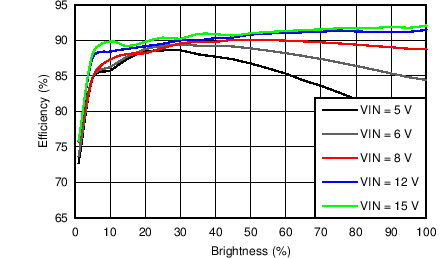
| ƒSW = 303 kHz | 8 LEDs/string | 150 mA/string |
| 4 strings |
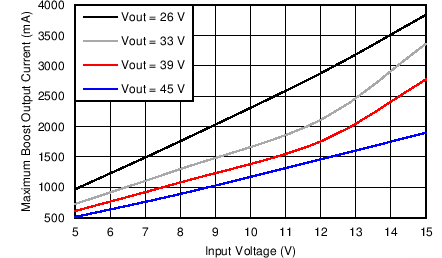
| ƒSW = 303 kHz | Adaptive voltage control off | ||
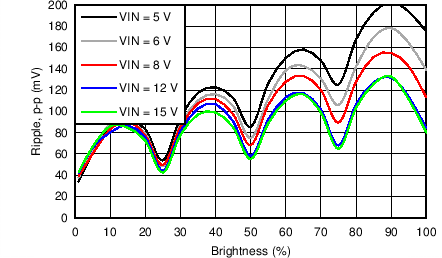
| ƒSW = 303 kHz | 8 LEDs/string | 150 mA/string |
| 4 strings | Phase shift 90º | ƒLED_PWM = 4.9 kHz |
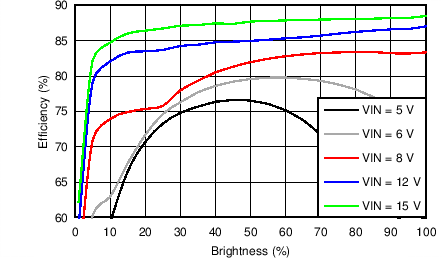
| ƒSW = 2.2 MHz | 8 LEDs/string | 100 mA/string |
| 4 strings |
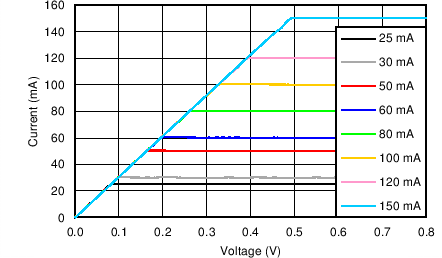
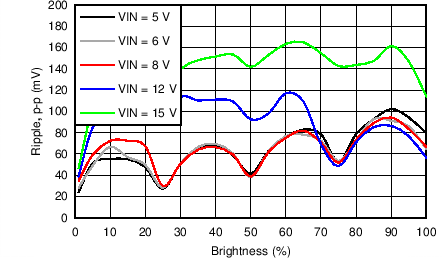
| fSW = 2.2 MHz | 8 LEDs/string | 100 mA/string |
| 4 strings | Phase shift 90º | fLED_PWM= 4.9 kHz |